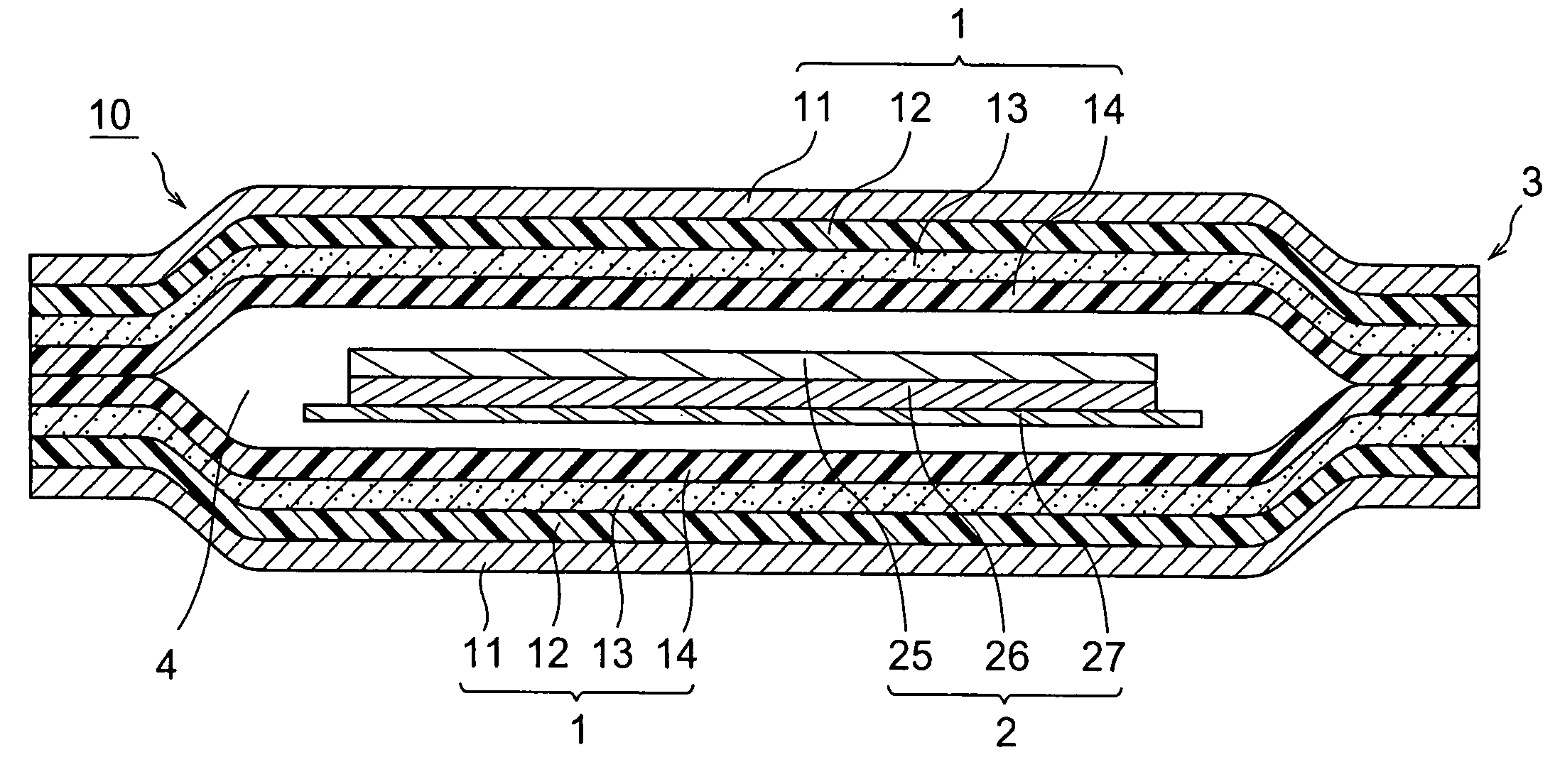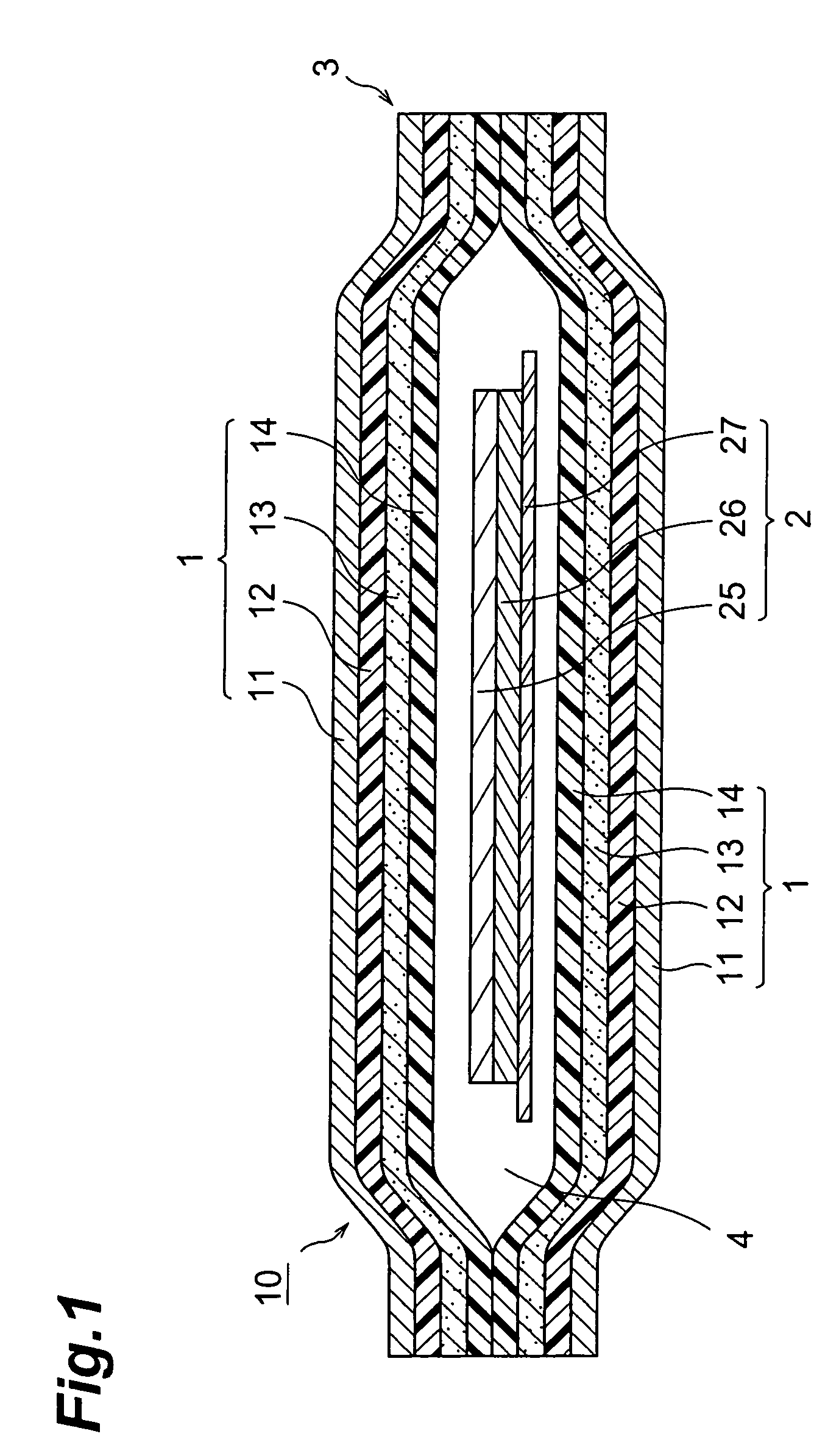Packaging bag for plaster and packaged plaster
a technology of packaging bags and plaster, applied in the direction of containers preventing decay, rigid containers, synthetic resin layered products, etc., can solve the problems of increased product bulkiness, increased cost, and existence of certain problems, so as to increase the scale and number of manufacturing steps, the effect of increasing the investment in manufacturing equipmen
- Summary
- Abstract
- Description
- Claims
- Application Information
AI Technical Summary
Benefits of technology
Problems solved by technology
Method used
Image
Examples
example 1
[0075](1) Fabrication of patch package: Each of the following layers was laminated in order, and then the surface of the screen material layer was coated with cellophane (thickness: 20 μm) to fabricate a laminated packaging material.[0076]Moisture-permeable material layer: LDPE (thickness: 10 μm, moisture permeability: 60 g / m2 / day)[0077]Hygroscopic material layer: LDPE (thickness: 30 μm, containing 30 wt % magnesium sulfate)[0078]Screen material layer: HDPE (thickness: 20 μm), aluminum foil (thickness: 9 μm)
[0079]The hygroscopicity of the laminated packaging material was measured to be 23 g / m2. This laminated packaging material was formed into a pouch with the moisture-permeable material layer on the inside and heat sealed to obtain a patch package.
[0080](2) Fabrication of patch: The components of the following formulation were heated to dissolution and the resulting pressure-sensitive adhesive was applied onto a support and covered with a liner, after which it was cut to obtain an ...
example 2
[0083](1) Fabrication of patch package: Each of the following layers was laminated in order, and then the surface of the screen material layer was coated with cellophane (thickness: 20 μm) to fabricate a laminated packaging material.[0084]Moisture-permeable material layer: LDPE (thickness: 5 μm, moisture permeability: 120 g / m2 / day)[0085]Hygroscopic material layer: LDPE (thickness: 30 μm, containing 38 wt % magnesium sulfate)[0086]Screen material layer: HDPE (thickness: 30 μm), aluminum foil (thickness: 15 μm)
[0087]The hygroscopicity of the laminated packaging material was measured to be 30 g / m2. This laminated packaging material was formed into a pouch with the moisture-permeable material layer on the inside and heat sealed to obtain a patch package.
[0088](2) Fabrication of patch: The components of the following formulation were heated to dissolution and the resulting pressure-sensitive adhesive was applied onto a support and covered with a liner, after which it was cut to obtain a ...
example 3
[0091](1) Fabrication of patch package: Each of the following layers was laminated in order, and then the surface of the screen material layer was coated with cellophane (thickness: 20 μm) to fabricate a laminated packaging material.[0092]Moisture-permeable material layer: LDPE (thickness: 15 μm, moisture permeability: 40 g / m2 / day)[0093]Hygroscopic material layer: LDPE (thickness: 30 μm, containing 20 wt % magnesium sulfate)[0094]Screen material layer: HDPE (thickness: 10 μm), aluminum foil (thickness: 5 μm)
[0095]The hygroscopicity of the laminated packaging material was measured to be 2 g / m2. This laminated packaging material was formed into a pouch with the moisture-permeable material layer on the inside and heat sealed to obtain a patch package.
[0096](2) Fabrication of patch: The components of the following formulation were heated to dissolution and the resulting pressure-sensitive adhesive was applied onto a support and covered with a liner, after which it was cut to obtain a di...
PUM
| Property | Measurement | Unit |
|---|---|---|
| thickness | aaaaa | aaaaa |
| thickness | aaaaa | aaaaa |
| thickness | aaaaa | aaaaa |
Abstract
Description
Claims
Application Information
 Login to View More
Login to View More - R&D
- Intellectual Property
- Life Sciences
- Materials
- Tech Scout
- Unparalleled Data Quality
- Higher Quality Content
- 60% Fewer Hallucinations
Browse by: Latest US Patents, China's latest patents, Technical Efficacy Thesaurus, Application Domain, Technology Topic, Popular Technical Reports.
© 2025 PatSnap. All rights reserved.Legal|Privacy policy|Modern Slavery Act Transparency Statement|Sitemap|About US| Contact US: help@patsnap.com


